Mission:House Featured in 2010 San Francisco Home Tours + Urban Interstice Gallery Opening
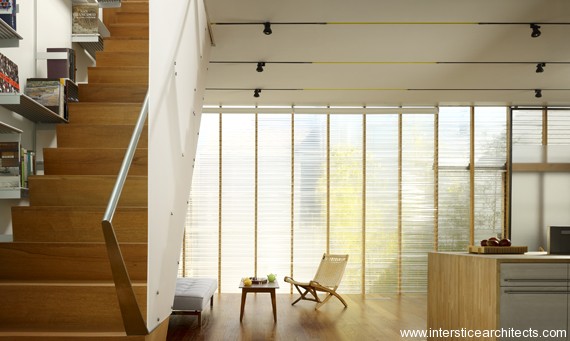
photo: Cesar Rubio
The San Francisco Architecture and the City Festival commences next week and we’re pleased to invite participants to both take a tour of our Mission:House, as well as view our newly completed Urban Interstice Gallery’s inaugural exhibit.
As a part of the San Francisco Living: Home Tours weekend event, guests will be able to tour some of the city’s most architecturally distinctive residences. The Mission:House will be one of the homes included on the tour, open for viewing on Saturday, September 12th.
The Mission:House is an 1100 sqft. “hybridizing” residence and living laboratory for a family of four (architect, landscape architect, and two daughters), who have made it their personal trial grounds for materials, light and unorthodox construction techniques. Experiments range from floors of expansive steel plates, walls of thermal plastics, and magnetic closet/display walls, to integrated passive energy strategies, ingenious waste-stream material reclamation, and high-tech thermal & solar power collection.
On the street a façade of shingled glass, built entirely of reclaimed material, creates an unusual “Greenskin” of refracted light through superimposed frames. Inside a 50-foot long wall of sliding doors reconfigure the ground floor studio while upstairs an operable skylight stretches across the house to let in the sky (and rain). A 30-foot rear façade of sliding corrugated thermal plastic, looks into the timber bamboo canopy. Translucent & luminous materials imbue the small home with a sense of volume and openness. Green magnetic walls slide and swing to absorb program, while the roof integrates an organic vegetable garden, hot tub, and a 4 kilowatt photo-voltaic array into a terraced topography of modular wood tiles.
If you are interested in learning more about the Mission:House, you can find more images and descriptions on our website. You can obtain more information regarding the Home Tours and reserve your spot by visiting www.aiasf.org/hometours.
Downstairs from the living spaces of the Mission:House will be the inaugural exhibit of our newly completed Urban Interstice Gallery, Public Networks of Urban Access. Relating to the Festival’s theme of “Investigating Urban Metabolisms,” the exhibit showcases the emerging network of pedestrian access and pedestrian-centered environments that have been designed, built and improved upon in the last two decades in San Francisco.
The emerging pedestrian network is one that highlights the changing priorities of urban dwellers. Priorities that are increasingly calling for the design of artifacts and architectural elements that bring us in contact with lost ecological systems, habitats and wilderness, and shelter us from the effects of the automobile. Through Design we are reclaiming sidewalks, streets and parking areas. Designers are finding creative ways to gain universal access to more wild landscapes, sensitive areas and the surrounding bay. The exploration of these projects will be presented in photographs, drawings and narrative falling into the following topical areas: Topographic Access, Pedestrian Streets, Water Access, Access to Sensitive Habitats.
We will be curating this exhibit which will showcase a number of public space projects in San Francisco. The opening reception will be Tuesday, September 14th at 5:00 pm, with the exhibit open through September 25th.
The Urban Interstice Gallery is located at 3443 26th Street, between Bartlett and Mission Streets (Google Map Link). Hours are from 2-6 pm Thursday – Saturday.
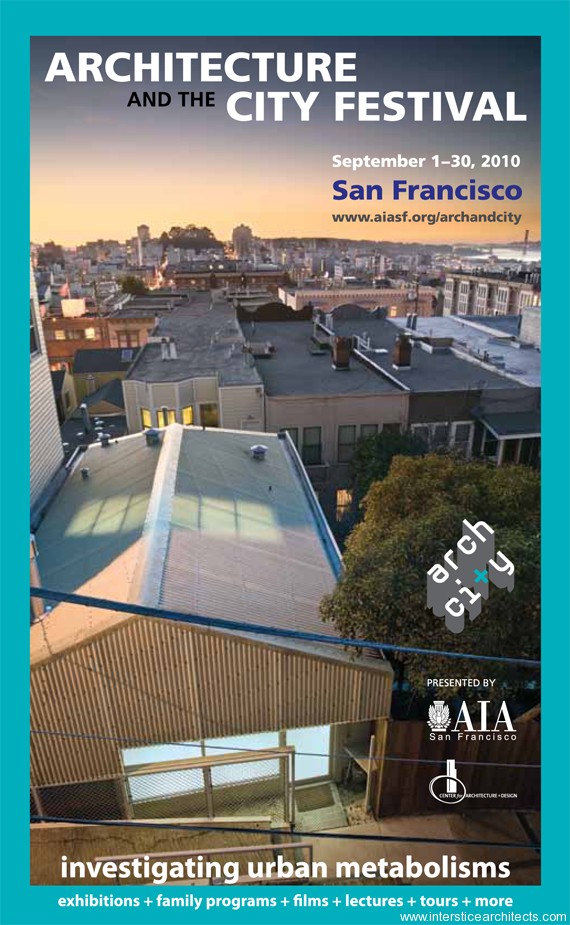
Agristructure | Ecostructure Featured in arcCA
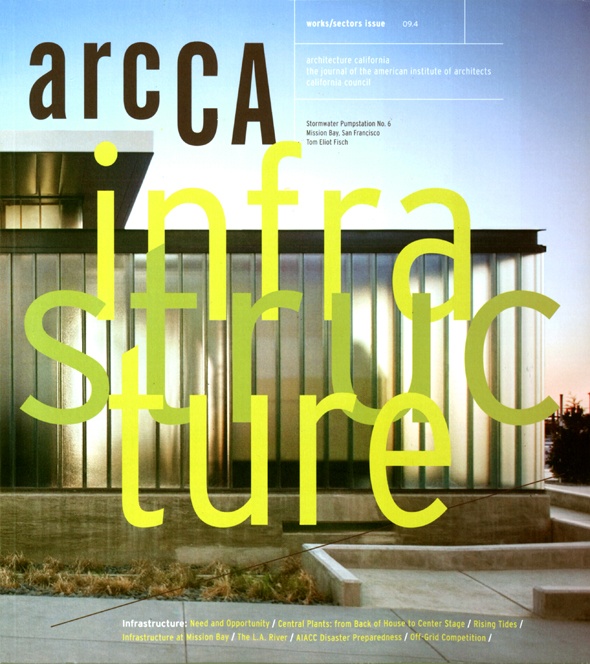
We are pleased to have our submission to the 2009 Off Grid 2.0 competition featured in the Works/Sectors Issue ( issue 09.4) of arcCA! Our project, titled “Agristricture | Ecostructure,” was awarded the Special Jury Commendation which in the words of the jury, “Was a very ambitious entry that explored teaching opportunities to a high degree … This solution is highly engaged in activities that support environmental learning.” The competition brief called for creative solutions to the remediation and redesign of Horseshoe Cove, a small ecological infill site that was once a marshland, drained and reclaimed by the military in the 1800s.

View of the New Horseshoe Cove from Kayak Launch
This project creates a high visibility public infrastructure that addresses the dynamic condition of the greater San Francisco Bay area ecosystem while creating a framework through which users may experience the ever changing local conditions of the site.
Given the increasingly complex shifts being brought upon Bay Area ecologies by global climate change, we believe that landscape itself can be a type of generative “soft” infrastructure, not only capable of fostering local remediation, but acting as an synthetically maintained ecological system which “seeds” other at risk ecological infill sites – re-establishing processes halted by years of development and environmental disruption.
Inspired by the research of Dr. Katharyn Boyer, the project’s two major functions are the replenishment of native eelgrass, and the production of critical natural resources to be used in a larger Bay-Wide remediation scheme.
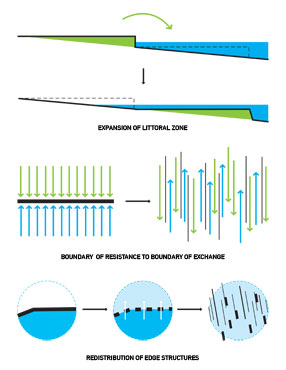
Site Strategy
This solution is initiated by first re-distributing the sea wall boundary, and transforming the site into a blurred tidal edge. We employ a series of simple performance typologies to create a sustaining landscape, and water/land ecologies evolve as we re-appropriate agricultural systems to create self-generating ecological structures. In shifting the context of these processes, we will also engender a transition from a culture of consumption to a culture of stewardship.
The site is organized and “grown” through the implementation of both Eco-structures and Agri-structures which create a highly concentrated wetland ecotone. These structures include redistributed land form, low-impact access catwalks, and distribution networks – together generating a site-wide “Plot” nursery for desperately needed habitats and endangered native species. The Plots are the biomass products of emergent wetland ecologies. The surplus production of the Plots is exported to other sites as they become available due to rising sea levels.
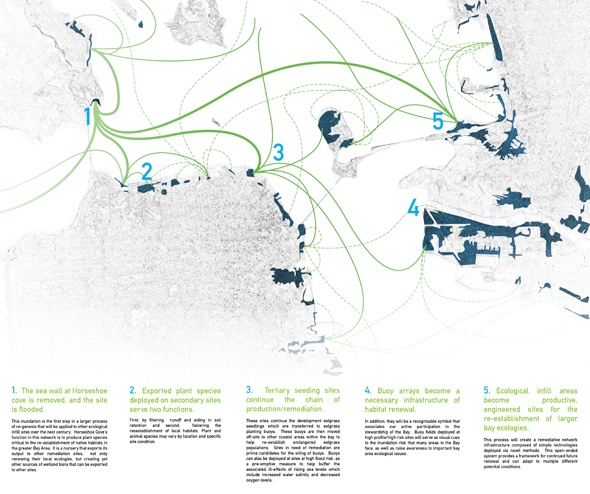
The "Remediative Network" - Mapping Potential Site Seeding
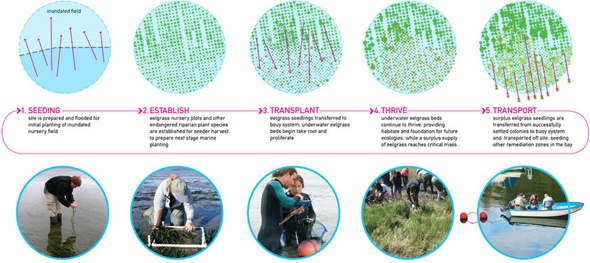
Eelgrass Cycle - Local Remediation Becomes Biomass Export
The simple flexible armatures, in turn, create program opportunities within the Plot nursery. The initial infrastructure recedes over time as proactive ecologies succeed. The Agri-structures remain, and are slowly reclaimed by the rising sea, eventually establishing a thriving marine estuary to become a destination for scientists, eco-tourists, and local residents alike. Our proposal is designed to remain perpetually unfinished, cultivating and capitalizing on emergent growth and flux, as the first node in an engineered remediation network of ecological and agricultural infill sites bay-wide.
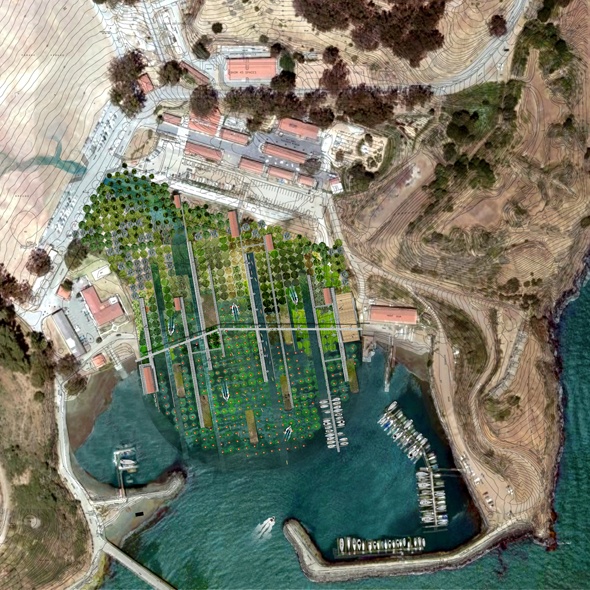
Plan - Ecological Infill or Productive Nursery?

Sections Through the Expanded Littoral Zone
Our design research for this project raised some topological questions regarding the role agriculture could play in ecological remediation, what the crossroads of infrastructure and natural systems might be like, the role of education in environmental design, and the true scales of impact local interventions could spark. These are by no means new questions, but given the current ecological and economic climate, we believe there is (or should be) a growing imperative towards open-ended, globally aware, locally sited design solutions. We want to rethink the idea of “public works” as a typically large, disruptive, and costly endeavor now replaced by smaller scale “soft” networks created through the exchange between a variety of fields, including architecture, landscape, environmental design, civil engineering, urban planning, logistics, social advocacy, and community leadership.
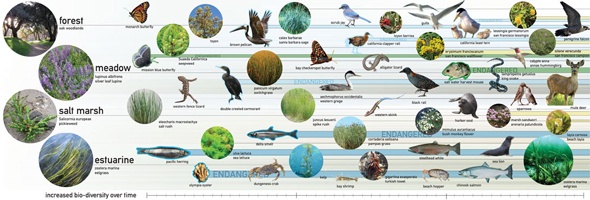
Ecological Web - Diversity Over Time
As we continue our research, we will document its progress on our blog – hoping to augment our findings through discussion and participation. We hope you enjoy putting forward whatever thoughtful insights, comments, criticisms, or resources you might have.
IA Wins AIACC Merit Award
We’re pleased to share that IA has received a Urban Design Merit Award from the AIA California Chapter for its project “Bay Remediation Site: 1” sited in Horseshoe Cove. This honor comes on the heels of the project’s recent AIASF award for Unbuilt Design earlier this year. The project will be published in ArcCA and AIArchitect later this fall, so keep an eye out!
We would also like to extend a heartfelt congratulations to all of our fellow Urban Design and Architecture award winners!
IA WINS AIASF CITATION AWARD
Interstice Architects has won a Citation Award from the AIASF in its 2012 Design Awards. IA’s winning entry “Bay Remediation Site:1” was the only landscape architecture entry to win in the Unbuilt Architectural Design category.

